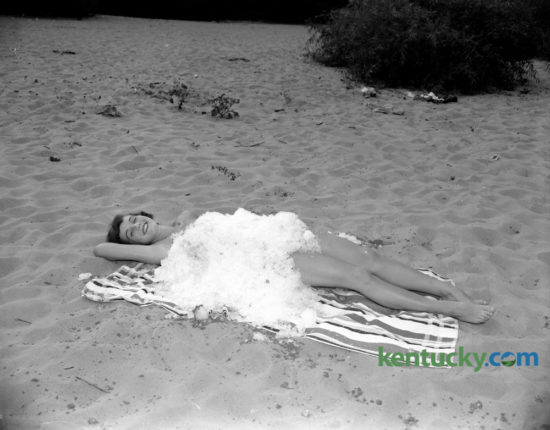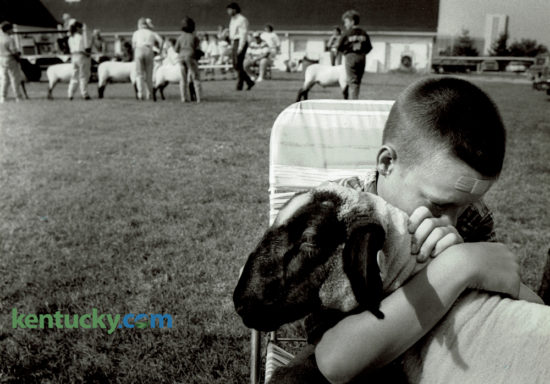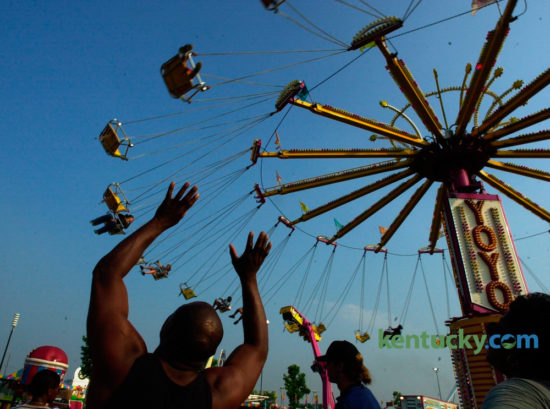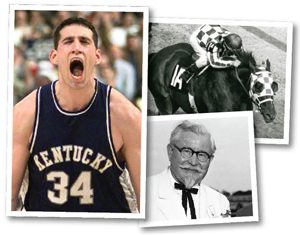October 14, 2025
Rupp Arena construction, 1975
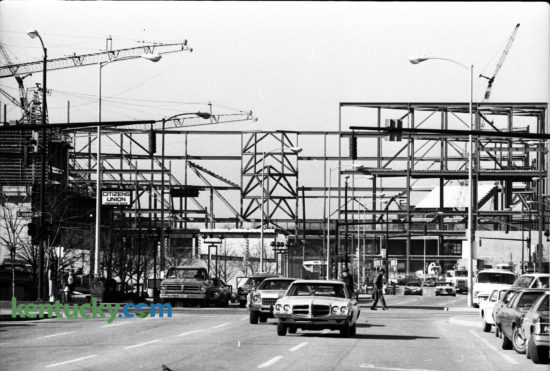
The steel superstructure of Rupp Arena loomed over the west end of downtown Lexington on Jan. 9, 1975, in a westward view on Vine Street from Limestone. Click here to see other Rupp Arena construction images from our archives. The grand opening of Rupp Arena was Oct. 7 to 10, 1976. For 99 cents, anyone could take a guided tour. When it opened, the Lexington Center was a five-fold operation: the convention-exposition hall, Rupp Arena, a shopping mall, the 17-story Hyatt Regency Hotel, and the Lexington Opera House. According to a 1976 article in the Herald-Leader, financing for Lexington Center and Rupp Arena was complicated, but it involved $66 million in private and public funding. $50.9 million of that was public money. Lawrence Welk was the first act to perform at Rupp Area, attracting 20,000 patrons on Oct. 17, 1976, for a 3 p.m. concert. On July 20, 2017, new designs were released of the long-awaited expansion of the Lexington Convention Center that include improvements for Rupp Arena. Photo by E. Martin Jessee | Staff
Begley’s Drug Store advertisement, 1967
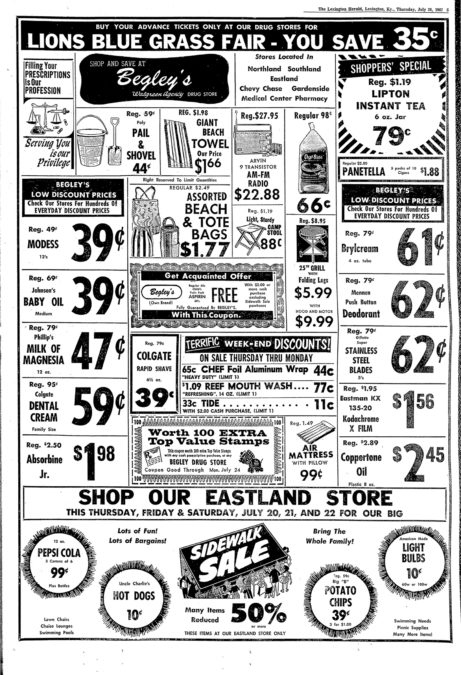
Full-page advertisement for Begley’s Drug Store in the July 20, 1967, Lexington Herald. The popular drug store chain had six stores in Lexington at the time: Northland, Southland, Eastland, Chevy Chase, Gardenside, and in the Lexington Medical Center at Nicholasville and Southland Drive. Begley, based in Richmond, had stores across Kentucky and once employed 1,400 people. It was bought by Rite Aid in 1988. Some of the summer-centric items advertised include: a beach pail and shovel for 44 cents, beach and tote bags for $1.77, a grill for $5.99, a pool float for 99 cents, and 18 12-ounce bottles of Pepsi Cola for 99 cents. Click on the image for a closer look.
UK sports legends Babe Parilli and Bill Spivey, 1951
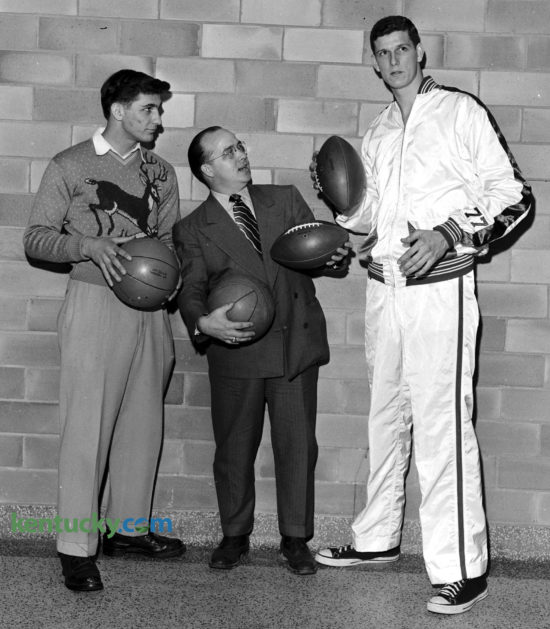
Posing with University of Kentucky sports publicity editor Ken Kuhn, football star Babe Parilli, left, and basketball star Bill Spivey traded equipment in January 1951 in Lexington. The photo ran Jan. 14, 1951, in the Sunday Herald-Leader, with a story about how the two stars came to UK on their own, neither being recruited by alumni or talent-hungry coaches. Click here to read that story. They would become what Kuhn described as the most publicized athletes in Kentucky history. At the time of this photo, Parilli was a couple weeks removed from leading the Wildcats to an upset over No. 1 Oklahoma in the 1951 Sugar Bowl. He helped bring national recognition to UK football during the golden era of Bear Bryant. A first-team All-American in 1950 and 1951 and a member of the National Football Foundation College Hall of Fame, Parilli died July 15. Spivey, one of the first 7-footers to play basketball in college, was in the middle of his second season with the Wildcats. He scored 22 points and grabbed 21 rebounds in leading UK to its third national title three months later. He was selected Helms Foundation national player of the year and a first-team All-American. Spivey later was implicated in a point-shaving scandal. Several UK Wildcats of the era admitted that they accepted money to shave points, but Spivey, who was indicted for perjury in the case but was acquitted, was adamant to the end of his life (he died in 1995 at age 66) that he never had any part in attempts to fix college games. Herald-Leader File Photo
Heat wave grips Kentucky, 1953
Onlookers at shooting scene, 1947
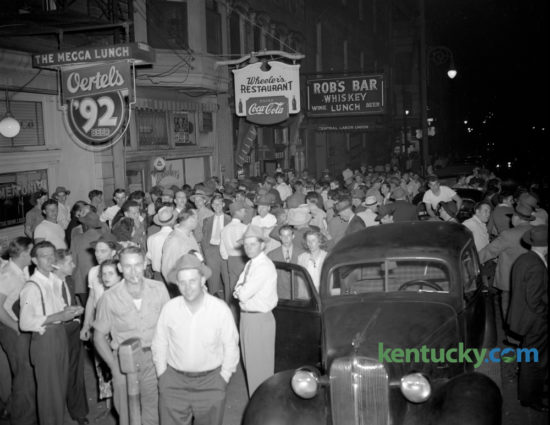
A crowd gathered outside Wheeler’s Restaurant, 110 North Broadway, on May 17, 1947, after the restaurant’s proprietor, Guthrie Wheeler, 41, his son Bobbie Lee, 17, and a waitress, Mrs. Mary Hamm, 36, were shot. Guthrie Wheeler died shortly after being admitted to St. Joseph’s Hospital. James Honaker, 29, of Carlisle, a World War II veteran who worked at the veterans hospital, was arrested. Honaker allegedly became enraged when the waitress refused to go out with him. A crowd estimated at 500 people milled around outside trying to get a vantage point to view the investigation. Herald-Leader Archive Photo
Lexington Farmers Market, 1977
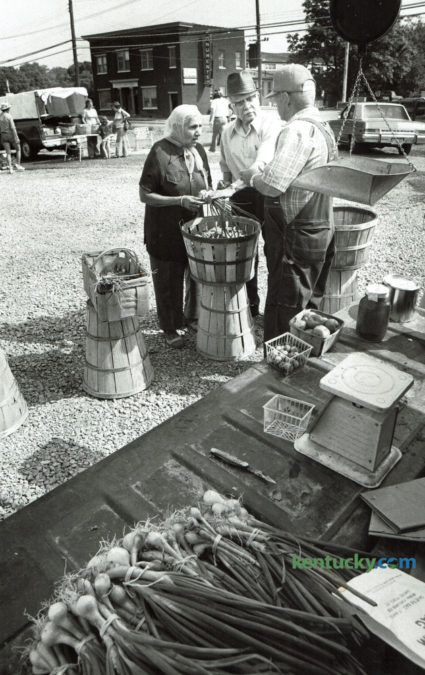
Garnett Edwards of Waco, Ky., right, sold produce at Lexington’s Farmers Market, which was on West Main Street across from Newtown Pike in May 1977. The market began in 1973 on the current site of the Civic Center. It then moved to this vacant lot on West Main Street in 1974. The Broadway and Maxwell Street site was used in 1979, and in June 1980, it moved to the north side of Vine Street between Vine and Upper streets, where it remained until moving to its current Saturday site in Cheapside Park in 2009. The Fifth Third Bank Pavilion was built in 2010. Photo by Ron Garrison | Staff
House being moved on Tates Creek Road, 1986
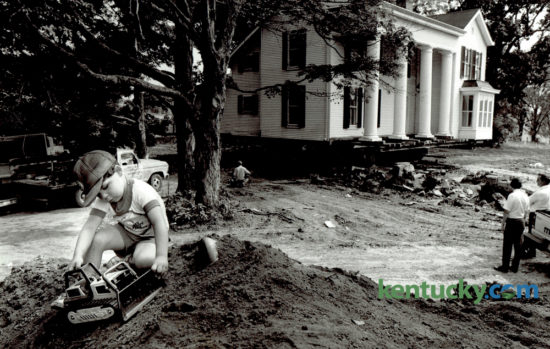
As Jason Edwards, 4, played with a toy earth-mover on July 22, 1986, his father, Mark Edwards, prepared to move a house. Edwards House Movers of Simpsonville, owned by Mark’s father, Bill, was moving the house to make room for a road leading to a new subdivision off Tates Creek Road. The house was owned by Ted Mims of Lexington. Photo by Gary Landers
Bluegrass Fair, 2000
In charge of V.A. hospital construction, 1944
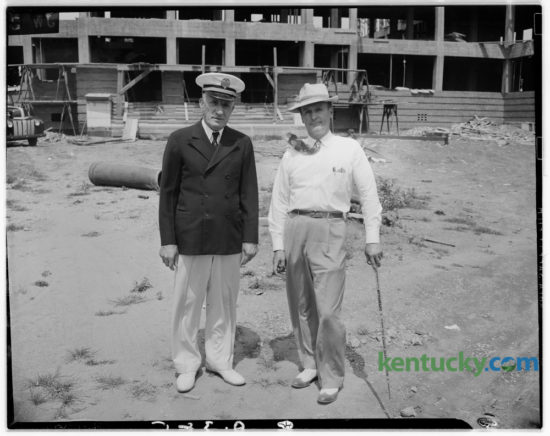
Capt. E.L. Townsend, left, utility officer, and his assistant, L.H. Hundley, superintendent of construction, stood in front of one of the 164-bed ward buildings under construction at the Veterans hospital on Leestown Pike in July 1944. The building was expected to be completed by late November. The Veterans Administration was to begin accepting bids for three more identical structures, bringing the hospital’s patient capacity to more than 1,300. These buildings, and two buildings built in 1938, would form a large square with the interior courtyard to be used by patients for recreational activities. Click on the image for a larger view. Herald-Leader Archive Photo

